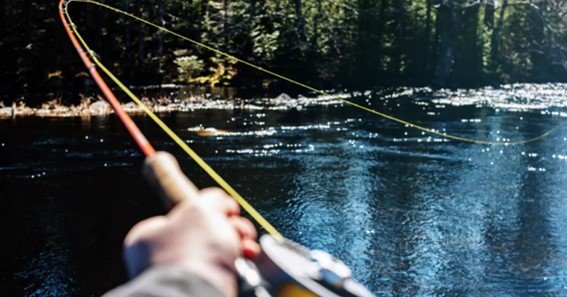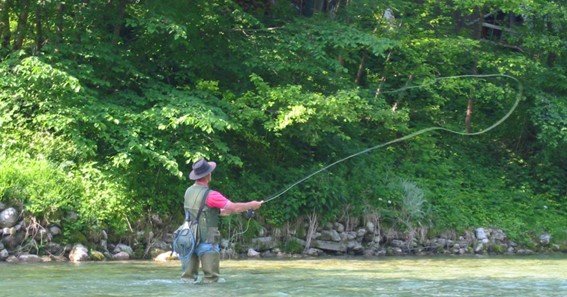What is fly fishing? Fly fishing is a centuries-old art, talent, and connection to nature. Fly fishing employs light bait called a fly that looks and moves like bugs and other animals to attract fish.
Imagine a peaceful river with water slowly rolling over boulders and an angler carefully throwing a line that dances through the air before resting softly on the water. This article discusses more on what is fly fishing.
What is Fly Fishing?
Fly fishing is a centuries-old angling method that uses artificial flies as bait to mimic the appearance and movement of insects and other prey. Fly fishing with artificial flies is unique. Feathers, fur, and thread make these flies look like water and land creatures. In conventional fishing, the lure’s weight advances the line.
Fly fishermen use the line’s weight to toss the practically weightless fly. This requires a particular fly rod, reel, and line that work together to delicately and accurately present the fly to the fish. This was a brief introduction on the question what is fly fishing.
Progression of Fly Fishing

Know about what is fly fishing is fine but how did it start? Fly fishing is old. The first written accounts are Roman. Roman scholar Claudius Aelianus wrote about Macedonian fishermen using imitation flies to catch fish in the second century AD. England’s fly fishing was significantly altered during the Middle Ages.
Upper-class individuals liked it. In 1653, Izaak Walton published The Complete Angler with precise instructions and philosophical views on fishing’s delights, making it even more popular. The world has adopted fly fishing over time to suit diverse fish species and situations. However, the sport’s fundamentals remain.
Fly Fishing Techniques
Now you already know what is fly fishing, next let’s know about its techniques. Fly fishing requires many techniques to master. Timing and control are needed to cast the fly into the water delicately, which is the most essential ability. Basic overhead, roll, and spey casts exist. Each has its ideal use.
Presentation is also crucial, including how the fly lands on the water and travels with the current to resemble animal prey. Anglers must learn to read the water and discover fish-eating spots. They must know how different fish species behave and what they prefer in order to choose the correct fly and presentation approach.
Types of Flies
Fly fishing requires careful fly selection. The three main fly kinds are dry, wet, and streamers. Dry flies resemble mayflies, caddisflies, and stoneflies and float on the water. Wet flies sink like drowned bugs, nymphs, and small fish.
Larger and heavier streamers resemble baitfish, leeches, and other larger meals. Different flies can be made and used depending on the fishing conditions, targeted species, and the angler’s ability level. Experienced fishermen bring many flies to adjust to changing weather and fish behavior.
Fly Fishing Gear

The sport of fly fishing requires specialized gear. The most significant gear is the fly rod, which has various lengths and weights for different fishing styles. The fly reel balances the rod and holds the line. Certain reels feature drag systems that make handling larger fish simpler. Fly lines vary in weight, taper, and density, influencing casting and presentation.
The line joins the fly last with leaders and tippets. OK, explicit material prevents fish from becoming spooked. Waders and wading boots assist anglers in wading deeper water, and belts and packs facilitate fly, tool, and other storage.
Environmental and Conservation Aspects
Fly fishing is for environmental protection. Many fishers advocate conserving fish-healthy natural environments. Many fly fishermen catch and release or handle and release fish to maintain fish populations.
Trout Unlimited and the Federation of Fly Fishers conserve and restore aquatic environments. This is done by encouraging responsible fishing and habitat protection. Fly fishing helps you connect with nature and understand how fragile marine ecosystems are and how crucial they are to future generations.
Joy and Challenge of Fly Fishing
All skill levels enjoy fly fishing, which is entertaining and challenging. Each excellent catch is pleasant since the sport requires patience, practice, and knowledge of nature. Fly fishing enables people to escape contemporary life and enjoy nature.
Fly fishing is enjoyable because of the rhythmic throwing action, the battle, and the hope that the fish will rise to the fly. Fly fishing is a journey of discovery, connection, and progress. No matter if you’re on a calm lake, secluded mountain stream, or crowded river.
Conclusion
Finally, fly fishing goes beyond fishing. An art, science, and means to interact with nature. Fly fishing has fascinated fishermen with its unique blend of skill, imagination, and environmental concern since its ancient roots.
Fly fishing is full of exciting adventures, new skills, and personal growth for all levels of fisherman. Learn about this traditional sport’s history, methods, gear, and environmental impact to truly appreciate it. Fly fishing catches fish well. This was a brief article for you to understand what is fly fishing.
FAQ
What is needed for fly fishing?
You only need a fly rod, reel, line, leads, tippets, and flies to start fly fishing. For deeper water, use waders and fishing boots.
Can I fly fish fresh and saltwater?
Fly fishing is possible in freshwater and ocean. Each area requires various gear and tactics to capture different fish.
Does fly fishing suit beginners?
Fly fishing takes practice and patience, but it’s exciting and rewarding. Beginning students can learn the essentials from books, DVDs, and classes.
What is the best time of year for fly fishing?
The optimal time to fly fish depends on your location and target fish. Trout fishing is usually best in spring and October, but some cold-water fly fishing spots allow fishing year-round.
How to choose a fly?
Fly selection depends on weather, fish behavior, and species. Look at local prey and chat with fly shops or experienced hunters to make the best option.
Sources:










